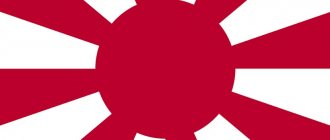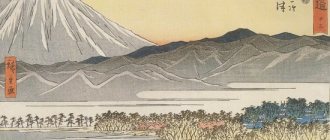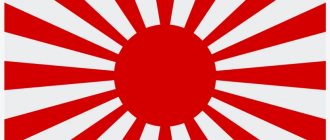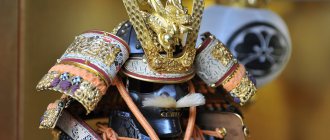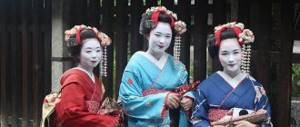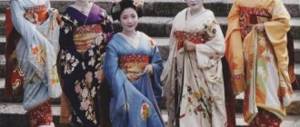The Japanese flag, also known as the Hinomaru and the sun flag, the sun circle is one of the main state symbols of the Land of the Rising Sun. Nisseki is a crystal white canvas with a red circle located in the center, symbolizing the rising daylight. The history of the state sign begins in the 13th century, the period of military conflict with Mongolia. The image was presented to the emperor by the powers as symbolizing the origin of the ruler from Amaterasu, the goddess of the Sun.
Symbol of the Land of the Rising Sun
Symbolism
The red circle on a white background symbolizes the sun, which rises in the east and illuminates the earth, giving people warmth and light.
The teachings of Shinto explain the colors of the cloth. Red is the color of life, the dawn sun and sacred fire, burning out misfortunes and vices. The white background is associated with truth and purity.
The design of the panel plays on the informal name of Japan - the Land of the Rising Sun. The origin of the nickname dates back to the 7th century. The first mention of the Japanese emperor as “Lord of the Land of the Rising Sun” was found in state correspondence with China.
The history of the origin of the symbols and colors of the flag.
Despite the widespread legend of the adoption of "hinomaru", which means the sun disk, as a symbol of the empire, the prototype, namely the same circle as on the flag of Japan, was a symbol widely used as decoration on the fans of military leaders during the Heian period (VIII - XII century). In those days, it was believed that Jimmu, the first emperor of heaven, defeated an enemy superior to his troops at the hour when the solar disk was behind him and blinded the enemy with its light. It was for this reason that military leaders believed in the symbol of the sun and displayed banners with a red circle behind their troops, it was believed that in this way they would call the power of the heavenly body to their side.
In the formation of the symbols that are already familiar to everyone, of course, the fact that Japan is the easternmost country also affected. In the ancient world they believed that in the morning the sun was born in the east; for the first time among Asian countries, the identification of Japan with the sunrise arose in Ancient China. The Japanese themselves were deeply convinced that the emperor was none other than a descendant of the sun goddess.
The red and white flag of Japan, which means an honest, untainted life lived in dignity and prosperity, owes its colors to Shintoism. In Shintoism, the color red symbolizes solar energy and flames, which carry the power of cleansing from vices and adversities. Red is also a symbol of life. White color in Shintoism symbolizes purity and purity.
Story
Early mentions of Japanese sun emblems are found in literary sources of the 12th century. The legend “About the House of Taira” mentions samurai fans with celestial patterns.
In the 13th century. The first Hinomaru flag was presented to the Japanese emperor by a Buddhist monk. The cloth was intended for the battle between the Japanese and the Mongols. The sun emblem was a reminder of the emperor's divine origins. The ruler was considered a direct descendant of the sun goddess Amaterasu.
In the 16th century Hinomaru flags spread among Japanese military leaders. The cloths played the role of a talisman. By raising the flag with the sun, the commanders ensured themselves the support of higher powers.
In the middle of the 19th century. The hinomaru became the distinctive sign of the state ships of Japan. In 1868, the first banner of the imperial army was developed - a red sun with 16 rays, placed on a white background.
Towards a modern image
In 1870, the sun flag established itself as a national symbol.
The image coincides with the modern design, but the shape of the flag was more elongated: the aspect ratio was 7:10.
During this period, Japan was experiencing the era of Meiji "enlightened rule". The country developed contacts with the outside world. The development of state symbols is a necessary measure to organize communication with other countries.
In 1885, the Meiji innovations were partially reversed. Legally, Hinomaru lost its status as a state symbol, but changes in legislation did not affect the practical use of the cloth.
In 1889, the flag of the Japanese Navy was created. A red sun with 16 rays was located on a white field to the left of center.
Since the beginning of the 20th century. Japan intensified its external expansion. Hinomaru rose during the Russo-Japanese War and armed conflicts with China and Mongolia. In the conquered territories, the white and red cloth was used for the ideological education of the population. The flag of the conquering country was raised not only on the streets, but also in schools in the new provinces. The children sang the Japanese national anthem while the hinomaru waved above their heads.
In the eyes of the international community, the solar flag was associated with the image of an eastern aggressor.
In 1945, after defeat in World War II, Japan came under US control. The use of state symbols was prohibited. To raise Hinomaru, permission from the American military administration was required. In 1949, occupation restrictions were lifted.
Japan changed its flag
In 1999, modern legislation on the state symbols of Japan was adopted. The act established the official status and modern proportions of Hinomaru. The aspect ratio became 2:3, while the old Japanese flag had 7:10.
In 2008, the Japanese Ministry of Defense made recommendations regarding the production of national flags. The clarifications affected the fabrics and colors of the design.
Official approval of the national flag
Representing the country through a flag, anthem, and coat of arms, as is customary in the West, was unusual for the Japanese for a long time. Heraldic elements were not considered necessary. The traditions of China, Korea and some other South Asian countries were similar. Only after the adoption of the national flag was a poem created, which, after being set to music, turned into an anthem. The anthem received official status in 1999.
Hinomaru became a recognized symbol of statehood much earlier. The status was first issued in 1871. The fate of the solar symbol is not simple: after 14 years, nisseki lost the legal right to represent the state due to a reform that invalidated laws not mentioned in the state gazette. Among others, the legal act dedicated to Hinomaru was also left out. In fact, however, they continued to use it.
In 1999, when the anthem was approved, it was determined that a law would be adopted to consolidate the solar symbol as the country’s flag. The moment marked the reassertion of one state symbol.
Hinomoto as a symbol of the country
World War II period
During World War II, Kyokujitsu-ki existed. It symbolized success. As a military sign, Kyokujitsu-ki has been used since 1854, and in 1870 it even received national status as part of the Meiji Revolution. Like Hinomaru, Kyokujitsu-ki is a daylight beginning to rise. There were two types of badge: for naval and ground forces. The naval version, adopted in 1889, was in effect until the end of the Second World War.
The defeat of Japan in 1945 was accompanied by the dissolution of the army and navy. Kyokujitsu-ki fell out of use, but was then reintroduced in 1954.
Countries that experienced Japanese aggression consider it unacceptable and offensive to use Kyokujitsu-ki.
Two-color image as a sign of power
Armed Forces Flags
The Japanese military flag is called Kyokujitsu-ki - “Flag of the Rising Sun”. The design feature is the presence of sun rays. Japanese military flags have been in use in their modern form since 1954.
- The symbol of the ground forces is a red sun with 8 rays, placed on a white field with gold trim around the edges.
- The flag of the naval forces - a solar disk with 16 rays is depicted on a white background and is offset to the left relative to the center. The flag follows the design of the 1889 naval ensign, but is a brighter shade of red.
Modern flag of Japan
The flag currently in use and very recognizable all over the world is a white cloth with a red circle in the center. This image is intended to symbolize the sunrise, which is also mentioned in the unofficial name of the country. In addition to the direct drawing, colors also matter. Thus, white expresses integrity and purity, and red – sincerity, warmth and brightness. After World War II, this state symbol was not popular for some time, but since August 13, 1999, it has been back in use. Its official name is "nisshoki". Translated into Russian it means “solar flag”. However, the more well-known phrase is “hi-no-maru”, which means “sun disk”. In general, three separate meanings can be distinguished in such an image. Firstly, the Emperor of Japan is considered a man of divine origin, that is, the son of the sun. Secondly, in Shintoism, which is the traditional Japanese religious belief system, red signifies life, fire and energy. Thirdly, the geographical location of the country also matters. It was previously believed that the Japanese archipelago is located at the eastern edge of the earth, from which the sun rises.
Flags of the Imperial Family
- The emperor's standard is a red cloth with a golden chrysanthemum in the center. The flower emblem serves as the national emblem of Japan. The image is taken from the emperor's personal seal. Chrysanthemum has been associated with happiness and longevity since the 12th century. considered the family sign of the imperial family.
- The empress's personal flag repeats the colors and design of her husband's standard. On the side of the panel opposite the shaft there is a dovetail cutout.
- The standard of the heir to the throne also has a triangular cutout. The chrysanthemum is surrounded by a white frame.
List of all flags of the countries of the World and subordinate territories, with two and three letter codes (ISO 3166)
| Flag | A country | Country abbreviation Alpha3 ISO 3166-1 | Country abbreviation Alpha2 ISO 3166-1 |
| A | |||
| Abkhazia | ABH | AB | |
| Australia | AUS | AU | |
| Austria | AUT | AT | |
| Azerbaijan | AZE | AZ | |
| Åland Islands (Finland) | A.L.A. | AX | |
| Albania | A.L.B. | AL | |
| Algeria | DZA | DZ | |
| American Samoa (USA) | A.S.M. | AS | |
| Anguilla (UK) | AIA | A.I. | |
| Angola | AGO | A.O. | |
| Andorra | AND | AD | |
| Antigua and Barbuda | ATG | A.G. | |
| Argentina | A.R.G. | AR | |
| Armenia | ARM | A.M. | |
| Aruba (Netherlands) | ABW | A.W. | |
| Afghanistan | AFG | A.F. | |
| B | |||
| Bahamas | B.H.S. | B.S. | |
| Bangladesh | BGD | BD | |
| Barbados | BRB | BB | |
| Bahrain | BHR | B.H. | |
| Belarus | BLR | BY | |
| Belize | BLZ | BZ | |
| Belgium | BEL | BE | |
| Benin | BEN | B.J. | |
| Bermuda (UK) | BMU | B.M. | |
| Bulgaria | BGR | B.G. | |
| Bolivia | BOL | B.O. | |
| Bonaire (Netherlands) | BES | BQ | |
| Bosnia and Herzegovina | BIH | B.A. | |
| Botswana | B.W.A. | B.W. | |
| Brazil | BRA | BR | |
| British Indian Ocean Territory (UK) | IOT | IO | |
| British Virgin Islands (UK) | VGB | VG | |
| Brunei | BRN | BN | |
| Burkina Faso | B.F.A. | B.F. | |
| Burundi | BDI | B.I. | |
| Butane | BTN | BT | |
| IN | |||
| Vanuatu | VUT | VU | |
| Vatican (Holy See) | VAT | V.A. | |
| Great Britain | GBR | G.B. | |
| Hungary | HUN | HU | |
| Venezuela | VEN | V.E. | |
| US Virgin Islands (US) | VIR | VI | |
| Vietnam | VNM | VN | |
| G | |||
| Gabon | GAB | GA | |
| Haiti | HTI | HT | |
| Guyana | GUY | G.Y. | |
| Gambia | GMB | G.M. | |
| Ghana | G.H.A. | G.H. | |
| Guadeloupe (France) | GLP | G.P. | |
| Guatemala | GTM | GT | |
| Guinea | GIN | GN | |
| Guinea-Bissau | GNB | G.W. | |
| Germany | DEU | DE | |
| Guernsey (UK) | GGY | GG | |
| Gibraltar (UK) | GIB | G.I. | |
| Honduras | HND | HN | |
| Hong Kong (China) | HKG | H.K. | |
| Grenada | GRD | G.D. | |
| Greenland (Denmark) | GRL | G.L. | |
| Greece | GRC | GR | |
| Georgia | GEO | G.E. | |
| Guam (USA) | GUM | G.U. | |
| D | |||
| Denmark | DNK | DK | |
| Jersey (UK) | JEY | JE | |
| Djibouti | DJI | DJ | |
| Dominica | DMA | DM | |
| Dominican Republic | DOM | DO | |
| E | |||
| European Union | EU | ||
| Egypt | EGY | E.G. | |
| Z | |||
| Zambia | ZMB | ZM | |
| Zimbabwe | ZWE | ZW | |
| AND | |||
| Israel | ISR | IL | |
| India | IND | IN | |
| Indonesia | IDN | ID | |
| Jordan | JOR | JO | |
| Iraq | IRQ | IQ | |
| Iran | IRN | IR | |
| Ireland | IRL | I.E. | |
| Iceland | ISL | IS | |
| Spain | ESP | ES | |
| Italy | ITA | IT | |
| Y | |||
| Yemen | YEM | YE | |
| TO | |||
| Cape Verde | CPV | CV | |
| Kazakhstan | KAZ | KZ | |
| Cayman Islands (UK) | C.Y.M. | KY | |
| Cambodia | K.H.M. | KH | |
| Cameroon | CMR | C.M. | |
| Canada | CAN | C.A. | |
| Qatar | QAT | QA | |
| Kenya | KEN | KE | |
| Cyprus | CYP | C.Y. | |
| Kyrgyzstan | KGZ | KG | |
| Kiribati | KIR | KI | |
| China | CHN | CN | |
| Cocos (Keeling) Islands (Australia) | CCK | CC | |
| Colombia | COL | CO | |
| Comoros | COM | K.M. | |
| Congo, Democratic Republic | C.O.D. | CD | |
| Congo, Republic | COG | C.G. | |
| Kosovo (Republic of Kosovo) | XXK | XK | |
| Costa Rica | CRI | CR | |
| Ivory Coast (Ivory Coast) | CIV | C.I. | |
| Cuba | CUB | C.U. | |
| Kuwait | KWT | KW | |
| Curacao (Netherlands) | C.U.W. | CW | |
| L | |||
| Laos | LAO | L.A. | |
| Latvia | LVA | LV | |
| Lesotho | LSO | L.S. | |
| Liberia | LBR | LR | |
| Lebanon | LBN | LB | |
| Libya | LBY | LY | |
| Lithuania | LTU | LT | |
| Liechtenstein | LIE | LI | |
| Luxembourg | LUX | L.U. | |
| M | |||
| Mauritius | MUS | M.U. | |
| Mauritania | MRT | M.R. | |
| Madagascar | MDG | MG | |
| Mayotte (France) | MYT | YT | |
| Macau (China) | MAC | M.O. | |
| Malawi | MWI | M.W. | |
| Malaysia | M.Y.S. | M.Y. | |
| Mali | MLI | M.L. | |
| Maldives | MDV | MV | |
| Malta | MLT | M.T. | |
| Morocco | MAR | M.A. | |
| Martinique (France) | MTQ | MQ | |
| Marshall Islands | MHL | M.H. | |
| Mexico | MEX | MX | |
| Micronesia | FSM | FM | |
| Mozambique | MOZ | MZ | |
| Moldova | MDA | M.D. | |
| Monaco | MCO | M.C. | |
| Mongolia | MNG | MN | |
| Montserrat (UK) | MSR | MS | |
| Myanmar (formerly Burma) | MMR | MM | |
| N | |||
| Namibia | NAM | N.A. | |
| Nauru | NRU | NR | |
| Nepal | NPL | NP | |
| Niger | NER | NE | |
| Nigeria | N.G.A. | NG | |
| Netherlands | NLD | NL | |
| Nicaragua | NIC | NI | |
| Niue (New Zealand) | NIU | NU | |
| New Zealand | NZL | NZ | |
| New Caledonia (France) | NCL | NC | |
| Norway | NOR | NO | |
| ABOUT | |||
| United Arab Emirates (UAE) | ARE | A.E. | |
| Oman | OMN | OM | |
| Ascension Island (UK) | SHN | SH | |
| Clipperton Island (France) | CPT | C.P. | |
| Isle of Man (UK) | IMN | I.M. | |
| Navassa Island (USA) | UMI | U.M. | |
| Norfolk Island (Australia) | NFK | NF | |
| Christmas Island (Australia) | CXR | CX | |
| Wake Island (USA) | W.A.K. | W.K. | |
| South Georgia Island and South Sandwich Islands (UK) | SGS | G.S. | |
| Kerguelen Islands (France) | ATF | TF | |
| Cook Islands (New Zealand) | COK | CK | |
| Pitcairn Islands (UK) | PCN | PN | |
| Saint Helena (UK) | SHN | SH | |
| Turks and Caicos Islands (UK) | TCA | TC | |
| Chatham Islands (New Zealand) | CIT | NZ | |
| P | |||
| Pakistan | PAK | PK | |
| Palau | P.L.W. | PW | |
| Palestine | PSE | PS | |
| Panama | PAN | PA | |
| Papua New Guinea | PNG | PG | |
| Paraguay | PRY | PY | |
| Peru | PER | P.E. | |
| Poland | POL | P.L. | |
| Portugal | PRT | P.T. | |
| Transnistria (Pridnestrovian Moldavian Republic) | — | — | |
| Puerto Rico (USA) | PRI | PR | |
| R | |||
| Reunion (France) | REU | RE | |
| Russia | RUS | RU | |
| Rwanda | R.W.A. | RW | |
| Romania | ROU | R.O. | |
| WITH | |||
| Saba (Netherlands) | BES | BQ | |
| Salvador | SLV | SV | |
| Samoa | WSM | W.S. | |
| San Marino | SMR | S.M. | |
| Sao Tome and Principe | STP | ST | |
| Saudi Arabia | SAU | S.A. | |
| Saint Vincent and the Grenadines | VCT | V.C. | |
| North Korea | PRK | KP | |
| North Macedonia (formerly Macedonia) | MKD | MK | |
| Northern Mariana Islands (USA) | MNP | MP | |
| Seychelles | SYC | S.C. | |
| Saint Barthelemy (France) | BLM | B.L. | |
| Senegal | SEN | SN | |
| Saint Martin (France) | MAF | M.F. | |
| Saint Pierre and Miquelon (France) | SPM | P.M. | |
| Saint Kitts and Nevis | KNA | KN | |
| Saint Lucia | LCA | L.C. | |
| Serbia | SRB | R.S. | |
| Singapore | SGP | S.G. | |
| Sint Maarten (Netherlands) | SXM | SX | |
| Sint Eustatius (Netherlands) | BES | BQ | |
| Syria | SYR | S.Y. | |
| Slovakia | SVK | S.K. | |
| Slovenia | SVN | S.I. | |
| USA | USA | US | |
| Solomon islands | SLB | S.B. | |
| Somalia | SOM | SO | |
| Sudan | SDN | SD | |
| Suriname | SUR | S.R. | |
| Sierra Leone | SLE | SL | |
| T | |||
| Tajikistan | TJK | T.J. | |
| Thailand | THA | T.H. | |
| Taiwan | TWN | TW | |
| Tanzania | TZA | TZ | |
| Timor-Leste | TLS | TL | |
| Togo | TGO | TG | |
| Tokelau (New Zealand) | TKL | TK | |
| Tonga | TON | TO | |
| Trinidad and Tobago | TTO | TT | |
| Tristan da Cunha (UK) | SHN | SH | |
| Tuvalu | TUV | TV | |
| Tunisia | TUN | TN | |
| Turkmenistan | TKM | TM | |
| Türkiye | TUR | TR | |
| U | |||
| Uganda | U.G.A. | U.G. | |
| Uzbekistan | UZB | UZ | |
| Ukraine | UKR | U.A. | |
| Wallis and Futuna (France) | WLF | W.F. | |
| Uruguay | URY | UY | |
| F | |||
| Faroe Islands (Denmark) | FRO | F.O. | |
| Fiji | F.J.I. | F.J. | |
| Philippines | PHL | PH | |
| Finland | FIN | FI | |
| Falkland Islands (UK) | FLK | FK | |
| France | FRA | FR | |
| French Guiana (France) | GUF | GF | |
| French Polynesia (France) | P.Y.F. | PF | |
| X | |||
| Croatia | HRV | HR | |
| C | |||
| Central African Republic | CAF | CF | |
| H | |||
| Chad Republic of Chad | TCD | T.D. | |
| Montenegro | MNE | M.E. | |
| Czech | CZE | CZ | |
| Chile | CHL | C.L. | |
| Sh | |||
| Switzerland | CHE | CH | |
| Sweden | S.W.E. | S.E. | |
| Svalbard and Jan Mayen (Norway) | S.J.M. | S.J. | |
| Sri Lanka | L.K.A. | L.K. | |
| E | |||
| Ecuador | ECU | E.C. | |
| Equatorial Guinea | GNQ | GQ | |
| Eritrea | ERI | ER | |
| Eswatini (formerly Swaziland) | SWZ | SZ | |
| Estonia | EST | E.E. | |
| Ethiopia | ETH | ET | |
| YU | |||
| South Africa | ZAF | ZA | |
| South Korea | KOR | KR | |
| South Sudan | SSD | SS | |
| I | |||
| Jamaica | JAM | J.M. | |
| Japan | JPN | J.P. | |
Data
- On August 13, Japan celebrates Hinomaru Day.
- According to 2008 regulations, military flags must be made of synthetic materials - nylon and acrylic.
- The old flag is subject to ceremonial burning in a private setting.
- "Hachimaki" is a Japanese headband in the shape of the national flag. Local residents see her as a personal talisman. The bandage is worn by everyone who wants to avoid misfortunes and strengthen strength: women before childbirth, students, office workers and athletes at competitions.
- Using Hinomaru as a commemorative card is a Japanese tradition that began during World War II. Paper images of the flag with good wishes were sent to the warring Japanese and were considered a protective amulet. The only condition is that the inscriptions must be located outside the solar disk.
- In the territories of Korea and China that survived Japanese occupation, hanging a Hinomaru is considered an insult to the nation.
Historical fact about military symbols
The samurai spirit was cultivated in the Japanese army, but for most of the rank and file it was not very close. Thoughts about home and relatives were more important to them. Because of this, a special tradition arose based on state symbols. When a soldier went to the front, he took with him a small Japanese flag, on which relatives and friends wrote wishes or special prayers for him. This canvas made of natural thin silk was a kind of gift from family, study or work colleagues, and sometimes from co-workers. The flag tradition was so widespread that privates had a special small bag for it in their duffel bags. Today, many museums store such mementos from the war.
National anthem of Japan
General information.
| Text | Phonetic transcription | Translation (N.I. Conrad) |
| いわおとなりて こけのむすまで | Kimi ga yo wa Chiyo ni yachiyo ni Sazareishi no Iwao to narite Koke no musu made | Sovereign century Thousands, millions of years Let it last! Until the Pebble became a rock, and grew gray with moss! |
Official name: 国歌 (kokka) Common name: “君が代” (kimi ga yo) - according to the first line
As with the national flag, the need to have modern state attributes appeared in Japan with the opening of the country during the Meiji period. In 1888, "Kimi ga yo" was first adopted as the country's official anthem.
Text.
The text for the anthem was a five-line tanka from the early 10th-century poetic anthology “Kokinshu” (“Collection of Old and New Songs”). So, despite the fact that the idea of adopting an anthem appeared in Japan later than in other countries, now the words of its anthem are the most ancient in the world. The author of the text is unknown. However, this five-line was quite popular and was included in later poetry collections, so its words have changed somewhat and the current version of the text differs from the original one.
A special feature of the five-line tanka is the large number of expressive means of language: epithets, figurative meanings of words, etc. That is why there is a need to interpret the meaning of what is written. So, for example, the first line – “Kimi ga yo” – causes great difficulty. In Japanese, the word "kimi" means "you", and is also a way of referring to the word "emperor". However, the generally accepted interpretation is the praise of the emperor, and the entire text proclaims the health resort to the sovereign.
In the era when these poems were composed, they were recited or sung. But the motive and manner of performance were exclusively traditional, so the music had to be brought into line with the musical norms of Western countries.
Music.
The very idea of adopting the anthem was first expressed by the Englishman John Fenton, who served as a conductor of the Japanese army. “Progressive” people of that time, who actively advocated reforms, provided him with the text of the tanka quintuple. However, the music composed by Fenton was considered unsuccessful because it lacked the proper degree of grandeur. After an unsuccessful attempt, the music department of the imperial court took up the matter, whose employee Hayashi Hiromori composed the music. After another military conductor, the German F. Eckert, edited the tune, the Japanese anthem was performed publicly for the first time on December 3, 1880. The official date of adoption of "Kimi ga yo" as the national anthem is considered to be 1888, when its music and lyrics were sent to all countries with which Japan had diplomatic relations.
As with the national flag, after the war the anthem became closely associated with a militaristic past. However, it was performed on NHK radio after the signing of the San Francisco Peace Treaty in 1951, and since 1953 it has been performed daily on the NHK television channel. In 1999, the anthem was again recognized as the official state anthem in the “Law on the National Anthem and National Flag”.
Why do countries have flags?
Flags are national symbols. Every country has a specific flag as its national symbol.
The first flags were flown in the 18th century to communicate to others that we owned a piece of land (“claim ownership”) and that we ruled the people and the land (“claim sovereignty”).
Flags show a demonstration that we belong to a community, organization or nation and share beliefs, goals, rules and norms.
Alley with flags near the UN headquarters in Geneva (Switzerland).
Country codes (ISO 3166) Alpha-2, Alpha-3
ISO country codes are internationally recognized codes that designate each country and most dependent territories with a two-letter combination or a three-letter combination; it's like an abbreviation for a country or state.
The country code is used, for example, for two-letter suffixes such as .us (USA), .fr (France) or .de (Germany) in top-level domains (for countries) on the Internet.
The three-letter code is also often used at events with international participants from different countries, such as sports meets or song competitions, where you may see abbreviations such as CAN (for Canada), DNK (for Denmark), AUS (for Australia).
The table above provides a list of two-letter codes (ISO alpha-2) and three-letter codes (ISO alpha-3), for countries and dependent territories. (Dependent territories are in italics).
